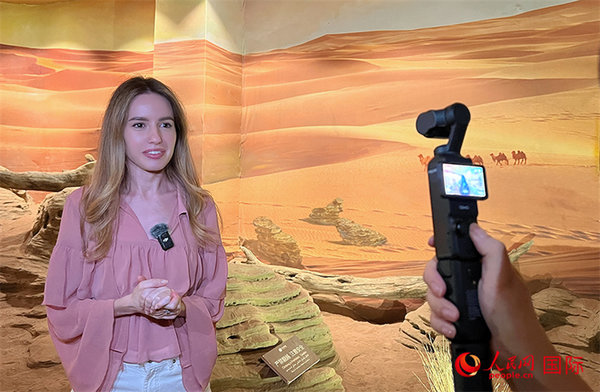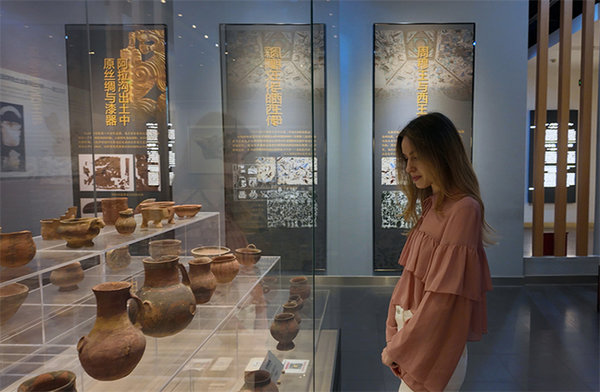Russian Woman Explores the Essence of NW China's Xinjiang
Upon hearing an elderly artist playing music with a traditional instrument, Vitalina Panovkina from Russia joined the man by playing a hand drum. This scene unfolded in the Bezeklik Thousand-Buddha Caves in northwest China's Xinjiang Uygur Autonomous Region, which Panovkina and other content creators were visiting during an activity titled "Remarkable Authors' Journey to Xinjiang."
Panovkina, fluent in Chinese, has been studying the language for nearly a decade. She is a livestreamer at Huaqiao University in southeast China's Fujian Province. Through videos and photos, she offers foreign audiences a genuine and comprehensive view of China.
 |
| Vitalina Panovkina films a video at a scenic spot of Karez wells in Turpan, northwest China's Xinjiang Uygur Autonomous Region. [People's Daily Online/Zeng Shurou] |
Before her trip to Xinjiang, Panovkina was often mistaken for a member of the ethnic groups in Xinjiang due to her fluent Chinese. This always puzzled her, but during her visit she observed people with distinct features similar to her own in the grand bazaar in Urumqi, the regional capital, which helped her comprehend why she was perceived as one of them. "On my initial day in Xinjiang, I grasped the concept of 'unity in diversity' within the Chinese nation," she shared.
Influenced by her teacher, Panovkina has a keen interest in exploring Chinese culture. "My teacher told me that to learn a language of a country well, you must understand its culture. China is so vast, with each region having its own unique cuisine and customs," she explained. "This is my first time in Xinjiang, and yesterday I tried the combination of milk tea and Nang, a kind of crusty bread typical of Xinjiang, which I found both intriguing and special."
 |
| Vitalina Panovkina explores the Turpan Museum in Turpan, northwest China's Xinjiang Uygur Autonomous Region. [Liu Yanxi] |
At the Turpan Museum, Panovkina was fascinated by the ancient artifacts on exhibit, such as the tomb guardian beasts, well-preserved mummies, ancient fossils, dumplings dating back over 1,000 years, and a scroll showcasing the homework of a 12-year-old student in the Tang Dynasty (618–907). She marveled at the remarkable preservation of these items. Additionally, she was captivated by the Karez wells, known as the "Underground Great Wall," and praised the ancient Chinese people's wisdom in living in harmony with nature.
(Source: People's Daily Online)
Editor: Wang Shasha
Please understand that womenofchina.cn,a non-profit, information-communication website, cannot reach every writer before using articles and images. For copyright issues, please contact us by emailing: website@womenofchina.cn. The articles published and opinions expressed on this website represent the opinions of writers and are not necessarily shared by womenofchina.cn.








.jpg)

 WeChat
WeChat Weibo
Weibo 京公网安备 11010102004314号
京公网安备 11010102004314号